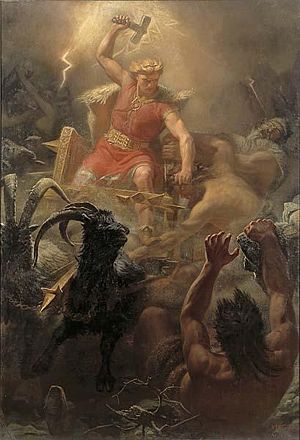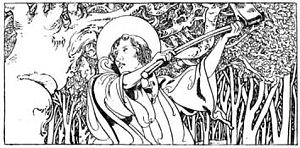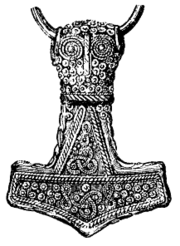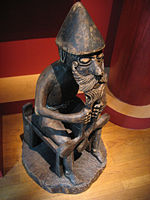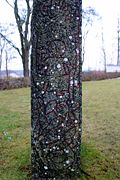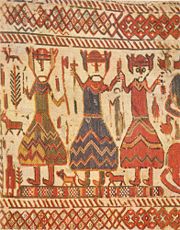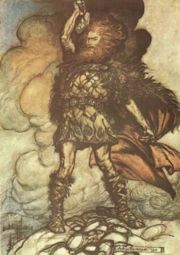Thor
2008/9 Schools Wikipedia Selection. Related subjects: Divinities
Thor ( Old Norse: Þórr) is the red-haired and bearded god of thunder in Germanic paganism and its subset Norse paganism. The god is also recorded in Old English as Þunor, Old Saxon as Thunaer, as Old Dutch and Old High German: Donar, all of which are names deriving from the Proto-Germanic *Þunraz.
Most surviving stories relating to Germanic paganism either mention Thor or centre on Thor's exploits. Thor was a much revered god of the ancient Germanic peoples from at least the earliest surviving written accounts of the indigenous Germanic tribes to over a thousand years later during the last bastions of Germanic paganism in the late Viking Age.
Thor was appealed to for protection on numerous objects found from various Germanic tribes and Miniature replicas of Mjolnir, the weapon of Thor, became a defiant symbol of Norse paganism during the Christianization of Scandinavia.
During and after the process of Christianization was complete, Thor was demonized by the growing influence of Christian missionaries. After Christian influence was cemented in law, traces of belief went increasingly underground into mainly rural areas, surviving until modern times into Germanic folklore and most recently reconstructed to varying degrees in Germanic neopaganism.
Etymology
The name Thor has the same origin as the word thunder, just as German Donner, Dutch donder, Swedish tordön, and Danish and Norwegian torden (with the suffix -dön/-den originally meaning "rumble" or "din").
Thor's Oak
Thor's Oak was an ancient tree sacred to the Germanic tribe of the Chatti, ancestors of the Hessians, and one of the most important sacred sites of the pagan Germanic peoples. Its felling in 723 marked the beginning of the Christianization of the non-Frankish tribes of northern Germany.
The tree stood at a location near the village of Geismar, today part of the town of Fritzlar in northern Hessen, and was the main point of veneration of the Germanic deity Thor (known among the West Germanic tribes as Donar) by the Chatti and most other Germanic tribes.
Old Saxon Baptismal Vow
Thor, as Donar, is mentioned in a Old Saxon Baptismal vow in Vatican Codex pal. 577 along with Woden and Saxnot. The 8th or 9th century vow, intended for Christianizing pagans, is recorded as:
- ec forsacho allum dioboles uuercum and uuordum, Thunaer ende Uuöden ende Saxnote ende allum them unholdum the hira genötas sint
Which translates to:
- I renounce all the words and works of the devil, Thunear, Woden and Saxnôt, and all those fiends that are their associates.
Temple at Uppsala
Between 1072 and 1076, Adam of Bremen recorded in his Gesta Hammaburgensis ecclesiae pontificum that a statue of Thor existed in the Temple at Uppsala and relates that:
- Thor takes the central position, with Wotan and Frey on either side. Thor, according to their beliefs, governs the air with its thunder, lightning, wind, rain, and fair weather. He is depicted carrying a scepter, much as our people depict Jove.
Eddic and skaldic depictions
The two sources largest in information regarding Thor are the Poetic Edda and Prose Edda.
Thor appears as the central figure in the following works of Norse literature:
- Þórsdrápa (summarized by Snorri Sturlason in Skáldskaparmál)
- Hárbarðsljóð which details a contest between Thor and Odin in the guise of Harbarth as to who is the most accomplished.
Thor also appears in:
- Gylfaginning
- Grímnismál
- Hymiskviða
- Þrymskviða
- Alvíssmál
- Lokasenna
- Völuspá
- Eiríksmál
- Ragnarsdrápa
- Húsdrápa
- Haustlöng
Sagas and Danish chronicles
Thor is also mentioned in 12th-15th century sources consisting of the sagas and Danish chronicles. They were sources which made use of skaldic poetry and oral traditions.
- Eyrbyggja saga
- Kjalnesinga saga
- Fóstbrœðra saga
- Fljótsdæla saga
- Hallfreðar saga
- Heimskringla
- Landnámabók
- Flateyjarbók
- Gesta Danorum
- Njáls saga
- Gautreks saga
Characteristics
Family
In the Poetic Edda and Prose Edda, Thor is the son of Odin and the giantess Jörd (Jord, the Earth). His wife is called Sif, and little is known of her except that she has golden hair. With his mistress, the giantess Járnsaxa, Thor had a son Magni and with Sif he had his daughter Thrud. There is nothing in the myths that states the identity of the mother of his son Modi.
The euhemeristic prologue of the Prose Edda also indicates he has a son by Sif named Lóriði, along with an additional 17 generations of descendants but the prologue is apocryphal and was meant to give a plausible explanation on how the Aesir came to be worshiped even though they were not gods in order to appease the Christian church. Thor also has a stepson called Ullr who is a son of Sif. Skáldskaparmál mentions a figure named Hlóra who was Thor's foster mother, corresponding to Lora or Glora from Snorre's prologue, although no additional information concerning her is provided in the book.
Mjolnir
Thor owns a short-handled hammer, Mjolnir, which, when thrown at a target, returns magically to the owner. His Mjolnir also has the power to throw lightning bolts. To wield Mjolnir, Thor wears the belt Megingjord, which boosts the wearer's strength and a pair of special iron gloves, Jarn Griepr, to lift the hammer. Mjolnir is also his main weapon when fighting giants. The uniquely shaped symbol subsequently became a very popular ornament during the Viking Age and has since become an iconic symbol of Germanic paganism.
Chariot
Thor travels in a chariot drawn by the goats Tanngrisnir and Tanngnjóstr and with his servant and messenger Þjálfi and with Þjálfi's sister Röskva. The skaldic poem Haustlöng relates that the earth was scorched and the mountains cracked as Thor traveled in his wagon. According to the Prose Edda, when Thor is hungry he can roast the goats for a meal. When he wants to continue his travels, Thor only needs to touch the remains of the goats and they will be instantly restored to full health to resume their duties, assuming that the bones have not been broken.
Bilskirnir
Thor lives in the palace Bilskirnir in the kingdom Þrúðheimr or Þrúðvangr.
Stories and myths
According to one myth in the Prose Edda, Loki was flying as a hawk one day and was captured by Geirrod. Geirrod, who hated Thor, demanded that Loki bring his enemy (who did not yet have his magic belt and hammer) to Geirrod's castle. Loki agreed to lead Thor to the trap. Grid was a giantess at whose home they stopped on the way to Geirrod's. She waited until Loki left the room then told Thor what was happening and gave him her iron gloves and magical belt and staff. Thor killed Geirrod and all other frost giants he could find (including Geirrod's daughters, Gjálp and Greip).
According to Alvíssmál, Thor's daughter was promised to Alvis, a dwarf. Thor devised a plan to stop Alvis from marrying his daughter. He told Alvis that, because of his small height, he had to prove his wisdom. Alvis agreed and Thor made the tests last until after the sun had risen--all dwarves turned to stone when exposed to sunlight, so Alvis was petrified.
Thor was once outwitted by a giant king, Útgarða-Loki. The king, using his magic, tricked Thor. The king raced Thought itself against Thor's fast servant, Þjálfi (nothing being faster than thought, which can leap from land to land, and from time to time, in an instant). Then, Loki (who was with Thor) was challenged by Útgarða-Loki to an eating contest with one of his servants, Logi. Loki lost, eventually. The servant even ate up the trough containing the food. The servant was an illusion of "Wild-Fire", no living thing being able to equal the consumption rate of fire. He called Thor weak when he only lifted the paw of a cat, the cat being the illusion of the Midgard Serpent. Thor was challenged to a drinking contest, and could not empty a horn which was filled not with mead but was connected to the ocean. This action started tidal changes. And here, Thor wrestled an old woman, who was Old Age, something no one could beat, to one knee. It was only later that Thor was told that he had in fact performed impressively doing as well as he did with those challenges.
Another noted story of Thor was the time when Þrymr, King of the Thurse (Giants), stole his hammer, Mjölnir. Thor went to Loki in hopes to find the culprit responsible for the theft. Loki and Thor went to Freyja for council. She gave Loki the Feather-robe so he could travel to the land of the giants to speak to their king. The king admitted to stealing the hammer and would not give it back unless Freyja gave her hand in marriage.
Freyja refused when she heard the plan so the gods decided to think of a way to trick the King. Heimdall, the fairest of the gods (and possibly one of the prophetic Vanir), suggested dressing up Thor in a bridal gown so he can take Freyja's place. Thor at first refused to do such a thing as it would portray him as a coward and womanish, but Loki insisted that he do so or the Giants would attack Asgard and win it over if he were not to retrieve the hammer in time. Thor reluctantly agreed in the end and took Freyja's place.
Odin rode Thor to the land of the Giants and a celebration ensued. The king noticed a few odd things that his bride was committing. He noted that she ate and drank more than what he would expect from a bride. Loki, who was in disguise as the false Freyja's servant, commented that she rode for 8 full nights without food eager to take his hand. He then asked why his bride's eyes are so terrifying, they seemed to be aglow with fire, again Loki responded with the fact that she did not sleep for 8 full nights eager for his hand. Then the giant commanded that the hammer be brought to his wife and placed on her lap. Once it was in Thor's possession he threw off his disguise and attacked all the giants in the room. Due to this ruse the giants were careful not to make the same mistake again.
Archaeological record
Thor was a very popular deity to the Germanic people and a number of surviving depictions of not only himself but also his exploits have survived many years of natural and intentional destruction.
Nordendorf fibula
Dating from the 7th century AD, the Nordendorf fibula, a human ( Alamannic) fibula found in Nordendorf near Augsburg ( Bavaria) bears an Elder Futhark inscription mentioning Donar, the Western Germanic tribes name for Thor.
Emblematic Mjolnir replicas
Widely popular in Scandinavia, Mjolnir replicas were used in Blóts and other sacral ceremonies, such as weddings. Many of these replicas were also found in graves and tended to be furnished with a loop, allowing them to be worn. They were most widely discovered in areas with a strong Christian influence including southern Norway, south-eastern Sweden, and Denmark. By the late 10th century, increased uniformity in Mjolnir’s design over previous centuries suggest it functioned as a popular accessory worn in defiance of the Christian cross.
Icelandic statue
A seated bronze statue of Thor (about 2.5 in, 6.4 cm) from about AD 1000 was recovered at a farm near Akureyri, Iceland and is a featured display at the National Museum of Iceland. Thor is holding Mjolnir, sculpted in the typically Icelandic cross-like shape.
Rune and image stones
Most Rune stones were raised during the 11th century and so they coincided with the Christianization of Scandinavia. Except for the Altuna Runestone which depicts a myth concerning Thor, there are only six runic inscriptions that appear to refer to him and five of them do so in invocations to consecrate the stones. Three of the inscriptions are found in Sweden (the Rök Runestone, Sö 140 and the Velanda Runestone) and three in Denmark (Dr 110, Dr 220 and the Glavendrup stone).
Thor's struggle with the Midgard Serpent as recorded in Hymiskviða can be found depicted on a number of image stones and Rune stones located in England, Denmark and Sweden respectively.
In the English village of Gosforth, Cumbria, the remains of a 10th century stone depicting Thor and Hymir fishing can be found along side numerous other Norse carvings.
In Denmark, a church in the small Northern Jutlandic town of Hørdum houses the remains of a stone featuring Thor and Hymir's fishing trip for the Midgard Serpent. Thor is wearing the distinct pointed helmet he is portrayed with in other found depictions and has caught the Midgard serpent while Hymir sits before him.
Sweden has two stones depicting this legend. Created sometime between the 8th and 11th centuries, the bottom left corner of the Ardre VIII stone in Gotland has often been interpreted as depicting not only the fishing trip but also references to the slaughter of the ox prior to using it as bait, potentially as part of an earlier version of the tale. The Altuna Runestone in Uppland depicts Thor fishing for the Midgard serpent. Though lacking Hymir, it notably displays Thor's foot breaching the floor of the boat during the intense struggle.
Kvinneby amulet
The Kvinneby amulet is an amulet that includes a runic inscription. There are competing theories about the exact wording of the inscription but all agree that Thor is invoked to protect with his hammer. According to Rundata, this inscription reads:
Here I carve(d) protection for you, Bófi, with/... ... ... to you is certain. And may the lightning hold all evil away from Bófi. May Þórr protect him with that hammer which came from out of the sea. Flee from evilness! You/it get/gets nothing from Bófi. The gods are under him and over him.
The amulet was found in the mid-1950's in the soil of the village Södra Kvinneby in Öland, Sweden. The amulet is a square copper object measuring approximately 5 cm on each side. Near one edge there is a small hole, presumably used for hanging it around the neck.
Skog Church Tapestry
A part of the Swedish 12th century Skog Church Tapestry depicts three figures often interpreted as allusions to Odin, Thor and Freyr. The figures coincide with 11th century descriptions of statue arrangements recorded by Adam of Bremen at the Temple at Uppsala and written accounts of the gods during the late Viking Age. The tapestry is originally from Hälsingland, Sweden but is now housed at the Swedish Museum of National Antiquities.
Thursday
Þunor gave his name to the Old English day Þunresdæg, meaning the day of Þunor, known in Modern English as Thursday. Þunor is also the source of the modern word thunder.
"Thor's Day" is Þórsdagr in Old Norse, Hósdagur in Faroese, Thursday in English, Donnerstag in German (meaning "Thunder's Day"), Donderdag in Dutch (meaning Thunder day), Torstai in Finnish, and Torsdag in Swedish, Danish, and Norwegian.
The day was considered such an important day of the week that as late as the seventh century Saint Eligius reproached his congregation in Flanders for continuing their native practice of recognizing Thursday as a holy day after their Christianization.
Personal names
The name "Thor", deriving from the deity, is the first element in many names:
- American female name: Donara (from the Old High German spelling)
- Norwegian masculine male names: Tor, Toralv, Torbjørn, Tore, Torfinn, Torgeir, Torgils, Torgny, Torgrim, Torkjell, Torlak, Torleif, Tormod, Torodd, Torolv, Torstein and Torvald.
- Norwegian female names: Torbjørg, Tordis, Torfrid (Turid), Torgerd, Torgunn, Torhild (Toril), Torlaug, Torunn and Torveig.
- Icelandic male names: Þór, Þórhallur, Þorbergur, Þorbjörn, Þorfinnur, Þorgeir, Þorgils, Þorgrímur, Þorkell, Þorlákur, Þorleifur, Þorsteinn, Þorvaldur, Þórarinn, Þórður and Þórólfur
- Icelandic female names: Þorbjörg, Þorgerður, Þóra, Þórdís, Þórhildur, Þórunn and Þórgunnur
- Faroese male names: Tór, Thór, Tórur, Thórur, Tórleif, Tórólvur
- Faroese female names: Tóra, Thóra
- Danish male names: Tor, Torben, Torbjørn, Torkil/Terkel, Torleif, Torsten, Torvald
- Danish female names: Tora, Tove
- Swedish male names: Tor, Torbjörn, Tord, Tore, Torgny, Torkel, Torleif, Torsten, Torvald
- Swedish female names: Tora, Torunn, Tove
- Scottish name: Torquil
- English surname: Thurkettle
- German male names: Thorsten/Torsten, Toralf
Toponyms
As a very popular god amongst the Germanic tribes, many locations have been named after Thor:
- Thorsberg moor, Germany (Thor's Hill) is an ancient location bearing a large deposit of numerous ritually deposited artifacts between the 1 and 4 BC by the Angles.
- Tórshavn, Faroe Islands (Thor's Harbour) is the capital city of the Faroe Islands.
- Thor's name appears in connection with groves (Lundr) in place names in Sweden, West Norway and Denmark.
- There are a number of Anglo-Saxon place names associated with Thor in England named Þunre leah (meaning "Grove or forest clearing of thunder") such as Thundersley in Essex, England.
- A "Forest of Thor" existed on the north bank of Liffey, Ireland outside of Dublin in the year 1,000 where it was destroyed over the course a month by Brian Boru, who took particular note of the oaks.
Parallels
Many writers ( Saxo, Adam of Bremen, Snorre Sturlason, Ælfric of Eynsham) identified Thor with Jupiter. The comparison can be borne: both are gods of the sky that control thunder and lightning, are children of the mother Earth and were at some time considered the most powerful of the gods. The oak tree was sacred to both gods and they had mysterious powers. Thor is to kill Jörmungandr and Jupiter, the dragon Typhon. Tacitus identified Thor with the Greco-Roman hero-god Hercules because of his force, aspect, weapon and his role as protector of the world.
Parallels with varying degrees of closeness can be found in other northern mythologies, such as Taranis (Celtic), Perkunas (Baltic), and Perun (Slavic), connected either to thunder, to oaks or to both. Additionally parallel either to Thor or Tyr are Finno-Ugric gods Torum, Thurms, Tere, etc. - see Tharapita.
Modern popular culture
Thor, under the German form of his name, "Donner", appears in Richard Wagner's opera cycle, Der Ring des Nibelungen. This has led to many portrayals based on Wagner's interpretation, although some are closer to pre-Wagner models. Since Wagner's time, Thor has appeared, either as himself or as the namesake of characters, in comic books, on television, in literature and in song lyrics.
Thor is the patron god of Uhtred Ragnarson in The Saxon Stories by historical novelist Bernard Cornwell.
